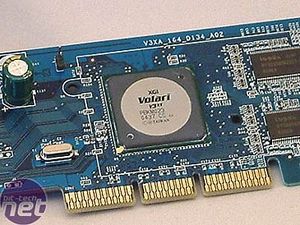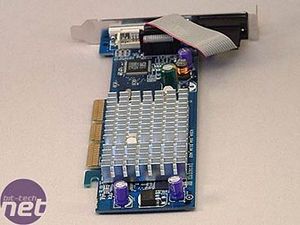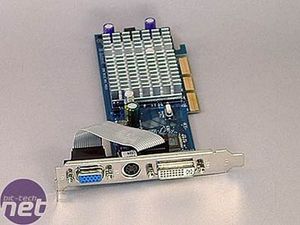Here at bit-tech, we have never looked at an XGI card until now, which makes this review unique in more ways than one. We have taken an excursion in to the world of budget video cards, where every penny/cent matters.
Xabre Graphics (XGI) is a name that many of us are not familiar with, so there's need for a brief history lesson to fill in a few gaps. XGI are the result of two of the many graphics vendors that existed during the mid nineties, namely SIS and Trident. The former bought out the latter to form Xabre Graphics, with the result being a collaboration of their knowledge of making 3D chipsets to produce XGI as they are now. SIS, under the brand name XGI, launched a series of mainstream and entry level video cards that provided some promise, but problems with driver stability and hardware bugs stopped them from ever gathering enough momentum to challenge the likes of ATI and NVIDIA.
Today, we are looking at Club3D's implementation of the XGI Volari V3XT, which is a budding solution for the Home Theatre PC junkie, who does not necessarily want to enjoy the latest games at high-resolution with all of the eye candy turned on. Instead, they want to enjoy high-quality movie or music playback without annoying levels of background noise from the source. Maybe you are just looking for a video card to display your desktop on so that you can browse the Internet without the annoyances of a whiney fan.
If that's where your interest lies, then an entry-level video card will certainly suit your needs. However, finding the best solution for the job is often not quite as easy as it may seem. Hell, you're only spending £35 - the differences between various products in that price range can't change that much, can they?

 XGI's Volari V3XT is based on the XG42 graphics core, clocked at 250MHz. The core has two fragment pipelines and one vertex shader that support both Pixel Shader and Vertex Shader 2.0 shaders; this means that the Volari V3XT is a DirectX 9.0 and OpenGL 1.5 capable video card. There is 128MB of DDR memory on the video card, and it is clocked at 200MHz (400MHz DDR).
XGI's Volari V3XT is based on the XG42 graphics core, clocked at 250MHz. The core has two fragment pipelines and one vertex shader that support both Pixel Shader and Vertex Shader 2.0 shaders; this means that the Volari V3XT is a DirectX 9.0 and OpenGL 1.5 capable video card. There is 128MB of DDR memory on the video card, and it is clocked at 200MHz (400MHz DDR).
Much like the ATI Radeon 9200 SE, the card has a 64-bit memory interface, which really limits the memory bandwidth that the Volari V3XT can deliver - we think it's fairly safe to say that we don't expect to be able to use Anti-Aliasing with a £35 video card. Also, the Volari V3XT is a low-profile card in the same way that the 64-bit 9200's are, which allows it to fit in to the low profile Home Theatre PC cases, such as the Hiper Media Chassis.

 The card is passively cooled by an aluminium cooler, which serves this card well - it does not generate a lot of heat, and the solution cools it adequately. Most importantly, it's attached firmly to the video card and makes good contact with the core - the pins used for attaching it are high-tension so that the heatsink does not wobble around. Of course, the video card generates no noise, as there's no fan - ideal for a home theatre solution, where noise is of utmost importance.
The card is passively cooled by an aluminium cooler, which serves this card well - it does not generate a lot of heat, and the solution cools it adequately. Most importantly, it's attached firmly to the video card and makes good contact with the core - the pins used for attaching it are high-tension so that the heatsink does not wobble around. Of course, the video card generates no noise, as there's no fan - ideal for a home theatre solution, where noise is of utmost importance.
The back plate has both DVI and VGA output ports, with the DVI connector connected directly from the PCB. The VGA connector is attached via a ribbon cable, but we noticed no quality differences between the two ports on a Sony Trinitron G400 CRT Monitor. The ports are powered by a RAMDAC clocked at 400MHz that allows for multiple monitor support. The back plate also has a TV-Out connector, which has support for HDTV 480i/480p/1080i/720p YPbPr output signals along with the typical Composite, S-Video, and Component RGB outputs.
The product specification states that there is a hardware MPEG-2 video decoder that is a part of the graphics core, it says that there is the ability for the GPU to make use of true hardware VCD, DVD and HDTV decoding, allowing for great movie playback. This is achieved with the Cipher Video Processor - the product feature page on XGI's home page states the following about the video processor:
We'll come to look at video playback a little later, as this card is designed for use in Home Theatre environments as opposed to the latest games.
Xabre Graphics (XGI) is a name that many of us are not familiar with, so there's need for a brief history lesson to fill in a few gaps. XGI are the result of two of the many graphics vendors that existed during the mid nineties, namely SIS and Trident. The former bought out the latter to form Xabre Graphics, with the result being a collaboration of their knowledge of making 3D chipsets to produce XGI as they are now. SIS, under the brand name XGI, launched a series of mainstream and entry level video cards that provided some promise, but problems with driver stability and hardware bugs stopped them from ever gathering enough momentum to challenge the likes of ATI and NVIDIA.
Today, we are looking at Club3D's implementation of the XGI Volari V3XT, which is a budding solution for the Home Theatre PC junkie, who does not necessarily want to enjoy the latest games at high-resolution with all of the eye candy turned on. Instead, they want to enjoy high-quality movie or music playback without annoying levels of background noise from the source. Maybe you are just looking for a video card to display your desktop on so that you can browse the Internet without the annoyances of a whiney fan.
If that's where your interest lies, then an entry-level video card will certainly suit your needs. However, finding the best solution for the job is often not quite as easy as it may seem. Hell, you're only spending £35 - the differences between various products in that price range can't change that much, can they?


Much like the ATI Radeon 9200 SE, the card has a 64-bit memory interface, which really limits the memory bandwidth that the Volari V3XT can deliver - we think it's fairly safe to say that we don't expect to be able to use Anti-Aliasing with a £35 video card. Also, the Volari V3XT is a low-profile card in the same way that the 64-bit 9200's are, which allows it to fit in to the low profile Home Theatre PC cases, such as the Hiper Media Chassis.


The back plate has both DVI and VGA output ports, with the DVI connector connected directly from the PCB. The VGA connector is attached via a ribbon cable, but we noticed no quality differences between the two ports on a Sony Trinitron G400 CRT Monitor. The ports are powered by a RAMDAC clocked at 400MHz that allows for multiple monitor support. The back plate also has a TV-Out connector, which has support for HDTV 480i/480p/1080i/720p YPbPr output signals along with the typical Composite, S-Video, and Component RGB outputs.
Features:
There are several features that are a part of XGI's XG42 architecture that are in need of a quick overlook. As we have already mentioned, the Volari V3XT is fully compatible with DirectX 9.0 with full support for both pixel and vertex shaders 2.0.The product specification states that there is a hardware MPEG-2 video decoder that is a part of the graphics core, it says that there is the ability for the GPU to make use of true hardware VCD, DVD and HDTV decoding, allowing for great movie playback. This is achieved with the Cipher Video Processor - the product feature page on XGI's home page states the following about the video processor:
- Volari™ V3XT processors feature XGI's legendary Cipher™ video processor. Leveraging this advanced de-interlacing technology means video files play with a smooth, flicker-free and fluid motion that amazes even industry professionals. And unlike competing video processors, the Cipher™ video processor converts both incoming and outgoing video feeds, ensuring that all your videos are displayed with the highest possible on-screen quality.
We'll come to look at video playback a little later, as this card is designed for use in Home Theatre environments as opposed to the latest games.

MSI MPG Velox 100R Chassis Review
October 14 2021 | 15:04







Want to comment? Please log in.